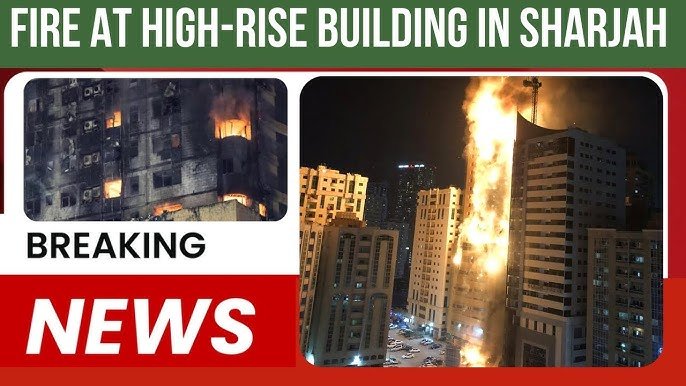On April 13, 2025, a devastating fire engulfed a towering 52-storey residential building in Sharjah’s Al Nahda area, shattering lives and raising urgent questions about high-rise safety protocols across the UAE. The inferno, which started in the morning hours, claimed the lives of five individuals and left 19 others injured. As smoke curled into the skies and panic set in among residents, the blaze marked one of the most distressing urban disasters the emirate has seen in recent years.
The shocking incident serves as a painful reminder of the stakes involved in residential safety, particularly in densely populated urban environments where towering skyscrapers dominate the skyline. But beyond the flames and charred walls, this tragedy is also a story of heroism, resilience, accountability, and the need for reform.
The Incident: Chaos Unfolds in Minutes
At around 11:30 a.m., alarms rang out as thick black smoke began pouring from the upper floors of the residential tower, located in one of the most active neighborhoods of Sharjah. Within minutes, the building turned into a towering inferno. Residents, many of whom were preparing for midday routines or enjoying time with their families, suddenly found themselves racing against time to escape.

Emergency responders from Sharjah Civil Defence arrived promptly and began evacuating residents while simultaneously battling the fire. Police and National Ambulance teams joined efforts to support the evacuation of nearly 1,500 people, providing medical attention on-site to those suffering from smoke inhalation and minor injuries.
Despite their valiant response, five lives were lost in the chaos. Eyewitness videos later emerged showing desperate attempts by residents to escape the fire. In one heart-wrenching clip, a man is seen descending the side of the building using a rope made of bedsheets. Tragically, the makeshift escape failed, resulting in a fatal fall.
Victims Identified: A Global Tragedy
Among the deceased were three Kenyan nationals, a Cameroonian, and one Pakistani. According to preliminary investigations, four of the five victims died after attempting to jump from the building in a desperate bid to escape the flames. The fifth, reports say, died from severe shock and asphyxiation.
The loss of these lives has reverberated far beyond the UAE. In Kenya and Pakistan, communities are mourning the deaths of their loved ones abroad. The incident has triggered diplomatic discussions around the protection of foreign workers and expats residing in high-density urban areas across the Gulf.
Families affected by the tragedy have called for thorough investigations and stringent legal action against those responsible for lapses in safety and emergency preparedness.
Investigation and Accountability
Sharjah authorities have moved swiftly in the aftermath. The Sharjah Police and Civil Defence have launched a full-scale investigation to determine the root cause of the fire and identify any structural or regulatory violations. Early reports suggest potential negligence regarding fire alarms, sprinklers, and other vital safety infrastructure.
Legal proceedings are already underway against the building’s owner and management company. Authorities are scrutinizing whether periodic maintenance and inspections were conducted and if previous safety recommendations were ignored.
In addition, forensics experts are combing through the debris to assess fire origins and the pattern of spread, which may hold key insights into whether flammable materials or faulty wiring contributed to the disaster.
Displaced Residents: Picking Up the Pieces
For the 1,500 residents who once called the tower home, the aftermath has been overwhelming. Many families have been left with nothing but the clothes they escaped in. Personal belongings, identification documents, cherished mementos, and years of savings were lost within minutes.
Relief organizations, including Emirates Red Crescent, stepped in almost immediately, providing emergency accommodations, food supplies, and psychological counseling to affected residents. Local volunteers, community leaders, and social service organizations have mobilized to support those in need, embodying the spirit of compassion and unity that the UAE is known for.
Sharjah authorities have temporarily relocated residents whose units were completely destroyed to alternative housing. For those with minor damage, re-entry protocols are being guided by safety assessments and structural stability checks.
The Fire Safety Debate Rekindled
In the wake of the tragedy, fire safety in high-rise buildings has become a major talking point across the UAE. While the country is recognized for its modern infrastructure and stringent building codes, experts argue that more proactive enforcement is required, especially in older buildings.
Urban planners, fire safety engineers, and civic officials are now re-evaluating policies on mandatory fire drills, accessibility of emergency exits, and the use of fire-retardant materials in residential structures. Many are advocating for smart fire detection systems and AI-driven evacuation protocols to be made standard in buildings housing more than 50 residents.
Moreover, questions are being raised about landlord accountability and the transparency of building inspection results. Some tenants allege they had previously raised concerns about malfunctioning fire alarms and the lack of regular safety drills—concerns that now seem eerily prophetic.
Leadership and Government Response
Sharjah’s leadership, led by His Highness Dr. Sheikh Sultan bin Muhammad Al Qasimi, has expressed deep sorrow over the tragedy. In a public statement, he emphasized the government’s commitment to full transparency during the investigation and pledged that such an incident should never occur again.
Senior officials from the Ministry of Interior and the National Emergency Crisis and Disaster Management Authority (NCEMA) have also joined the inquiry process and are working toward an enhanced national framework for fire safety and urban disaster response.
The UAE government is expected to announce new policies in the coming weeks that will enhance residential safety standards and require updated certifications from building owners across the country.
A Wake-Up Call
For many, the Sharjah high-rise fire is more than just a tragic incident—it’s a wake-up call. It has unveiled systemic issues that require urgent attention: maintenance lapses, emergency readiness, and regulatory compliance. But it has also shown the resilience of the people of Sharjah and the strength of the UAE’s emergency response system.
In a city known for its ambition and rapid growth, the fire reminds us of the balance that must be struck between expansion and safety. The tragedy has deeply affected the public conscience and prompted a national conversation about how urban development can evolve without compromising the well-being of its people.
As Sharjah heals and the affected families begin to rebuild their lives, the nation must carry the weight of the lessons learned. The flames have died out, but the call for change continues to burn strong.
Do follow Uae stories for more Updates













